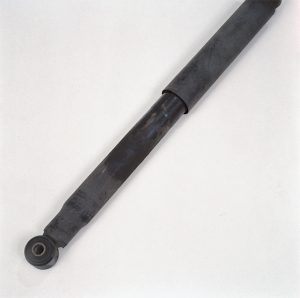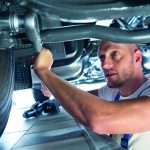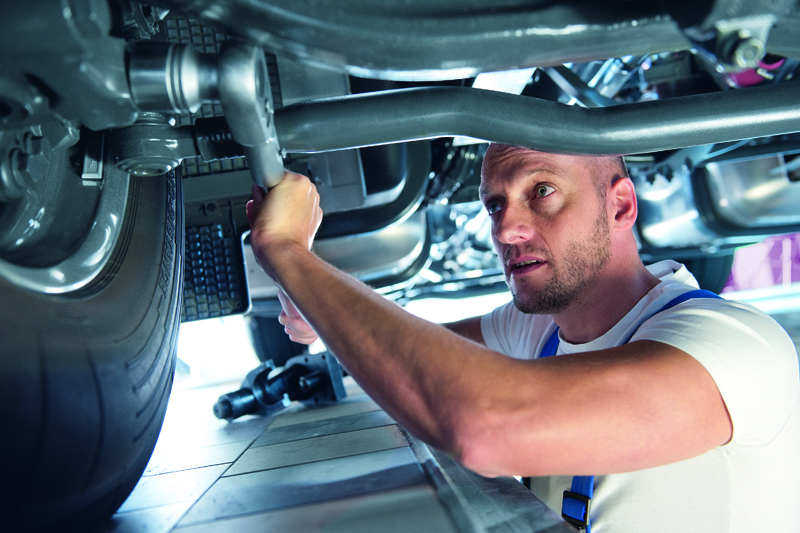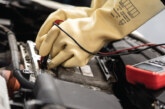Wayne McCluskey, of ZF Aftermarket, explains that annual testing should be the absolute minimum commercial vehicles adhere to, with CV operators encouraged to have their vehicles inspected more regularly – especially when it comes to shock absorbers.
While the legal requirement for annual MOT testing for commercial vehicles is well understood, there’s a strong case for undertaking testing more frequently. The sheer number of miles travelled, mean that not only is the vehicle operating for more hours than the average passenger car, but it’s also exposed to a far greater amount of potholes. These poor road conditions can adversely affect steering and suspension – accelerating damage and threatening safe operation.
Oil mist on shock absorber
According to the Department of Transport’s Road Use Statistics 2016, commercial vehicles are working harder than ever, with trucks and buses covering a combined 18.8 billion miles each year. In parallel, road conditions are tricky – it has been reported that in 2016, more than 2.1 million potholes were filled nationwide at a cost of over £118 million.
It’s fair to assume that every CV drivers’ chances of hitting a pothole are increasing. As steering and suspension are among the most common causes of MOT failure, any sudden shock or misalignment due to uneven road surfaces can severely compromise the safety and stability of the vehicle. Critical damage can occur at any time – even on the same day as the MOT is passed – meaning regular inspection and testing is crucial.
Avoiding ‘sudden’ failures
When the causes of component failure are considered, ‘sudden’ failures are usually not so sudden at all, as many can be predicted and prevented through smart maintenance practices. For example, consider shock absorbers – when only the damaged asset is replaced, rather than the pair, unequal damping performance across the axle will result. The older shock absorber will then be at even greater risk of wear, and given the miles travelled by the HGV or coach, it will most likely fail before its next MOT. Replacing in pairs will even out damping performance leading to an increased service life for both shock absorbers – and more regular testing will flag such issues before the damage becomes critical and dangerous.

Identifying potential damage
While oil leakage is one of the most common issues affecting shock absorbers, it’s also one of the easiest to misdiagnose. For example, when looking for a leak it’s usual to find a light misting of oil on the outer tube next to the seal of the shock absorber. Rather than indicating leakage, this is completely normal – every stroke of the piston rod results in oil transfer from the working chamber to the piston rod seal to keep it lubricated. So rather than looking for any presence of oil, only large streaks or volumes of oil should be a cause for concern as these lead to a loss of damping force and reduced tyre grip – and eventually, to a failed annual test.
Accurate inspection will depend on the testing environment, too. A truck or bus coming in on a rainy day should be allowed to dry before inspection, and the component should also be decontaminated. Occasionally, what appears to be an oil leak, may, instead, be a build-up of road dirt or anti-corrosion wax. This type of contamination may also reduce the shock absorber’s ability to dissipate heat, meaning it should be removed before inspection.
Preventing further damage
Some instances of shock absorber damage can be attributed to accident damage, but in other cases, errors in maintenance are to blame – for example side loading, for which the most likely cause is fully tightening the shock absorber mounting without the vehicle weight acting on the suspension. This occurs if, for example, the wheels are hanging free while the vehicle is on the ramp, and leads to the shock absorbers’ axle and body mountings effectively becoming fixed in place due to the change in angle. With the mountings unable to move, the shock absorber itself tries to bend, causing undue stress on the unit and resulting in wear on the piston rod guide and seal. Unfortunately such damage usually goes unnoticed until it is enough to cause a leak, by which time a full replacement is likely to be needed.
To avoid side loading, the shock absorber mountings should be fitted hand- tight before lowering the vehicle weight onto the wheels to preload the suspension. The correct torque can then be achieved by further tightening with hand tools.
High quality parts
When selecting replacement parts it’s always recommended that workshops use OEM quality products to provide peace of mind. ZF Aftermarket provides Sachs shock absorbers and Lemförder chassis
and steering components that are manufactured using high quality materials and undergo rigorous testing. This means they can be expected to perform reliably, offering a ‘fit and forget’ concept. In comparison, cheaper rubber-to metal alternatives are often made from substandard rubber, and quickly manufactured without care. Parts from an undependable origin are best avoided from a safety point of view.
Suggesting regular testing
Around one in four vehicle breakdowns could have been prevented if the problem had been reported earlier, according to a CV-specific survey by the RAC. Some 40% of those surveyed said that at least two of their fleet vehicles were off the road due to breakdown each month and, in monetary terms, breakdowns and CV downtimes can cost up to £300 a day.
It’s therefore well worth recommending more regular testing to customers who are looking for maximum uptime. Making CV operators more aware of false economies, such as replacing shock absorbers individually, may well result in more business and a happier, safer customer – while following workshop best practice for inspecting and fitting shock absorbers will build confidence and prevent unnecessary damage.










